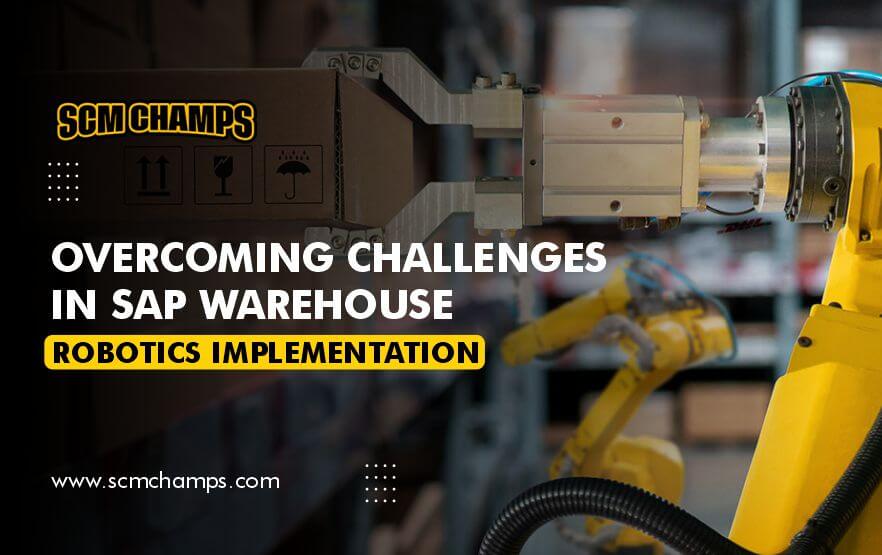
SAP Warehouse Robotics (SAP WRS) is a comprehensive solution that integrates robotics into the SAP Extended Warehouse Management (EWM) system. It offers a wide range of functionalities to automate warehouse processes, such as picking, packing, and shipping. However, implementing SAP WRS can be a complex undertaking, and there are a number of challenges that need to be considered.
In this write-up, we will discuss the common challenges faced during the implementation of SAP WRS and provide practical solutions to ensure a smooth transition.
Common Challenges Faced During SAP WRS Implementation
There are a number of common challenges faced during the implementation of SAP WRS. These challenges can be categorized into three main areas:
1. Planning and Preparation
a) Lack of a clear business case: Without a clear business case, it is difficult to justify the investment in SAP WRS and to measure the return on investment (ROI).
b) Inadequate process mapping: Without a clear understanding of the current warehouse processes, it is difficult to identify which processes are best suited for automation.
c) Insufficient stakeholder buy-in: It is important to get buy-in from all stakeholders, including warehouse managers, IT staff, and end-users.
2. Technical Implementation
a) Integration with SAP EWM: SAP WRS needs to be seamlessly integrated with SAP EWM to ensure that data is shared effectively between the two systems.
b) Robotics hardware and software selection: There is a wide range of robotics hardware and software solutions available, and it is important to select the right solutions for the specific needs of the warehouse.
c) Robotics configuration and programming: Robots need to be configured and programmed correctly to perform the required tasks accurately and efficiently.
3. Change Management
a) Training and education: Warehouse staff need to be trained on how to use the new robotics system.
b) Communication and feedback: It is important to communicate effectively with warehouse staff throughout the implementation process and to gather feedback to ensure that the system is meeting their needs.
Practical Solutions to Ensure a Smooth Transition
There are a number of practical solutions that can be implemented to overcome the challenges of SAP WRS implementation. These solutions include:
1. Develop a strong business case: Clearly define the benefits of implementing SAP Warehouse Robotics, such as increased productivity, reduced costs, and improved accuracy.
2. Perform thorough process mapping: Identify the most suitable processes for automation and document the current state of these processes.
3. Secure stakeholder buy-in: Engage with stakeholders early on in the project and address their concerns.
4. Seek expert guidance: Consult with experienced SAP WRS implementation partners to gain valuable insights and expertise.
5. Conduct comprehensive testing: Thoroughly test the SAP WRS system in a staging environment before deploying it to the production environment.
6. Provide ongoing training and support: Offer ongoing training to warehouse staff and provide them with a support channel for any questions or issues they may encounter.
SAP Warehouse Robotics Services
There are a number of SAP Warehouse Robotics services available to help companies implement and support SAP WRS. These services can provide valuable assistance in all phases of the implementation process, from planning and preparation to change management.
Some of the key services offered by SAP Warehouse Robotics partners include:
1. Business case development
2. Process mapping and analysis
3. Robotics hardware and software selection
4. Robotics configuration and programming
5. Integration with SAP EWM
6. Testing and validation
7. Training and Education
8. Ongoing support and maintenance
By engaging with an experienced SAP Warehouse Robotics partner, companies can ensure that their SAP WRS implementation is a success.
Conclusion
SAP Warehouse Robotics can offer a number of benefits to businesses, such as increased productivity, reduced costs, and improved accuracy. However, implementing SAP WRS can be a complex undertaking, and there are a number of challenges that need to be considered.
By following the practical solutions outlined in this write-up, companies can overcome these challenges and ensure a smooth SAP WRS implementation. Additionally, engaging with an experienced SAP Warehouse Robotics partner can provide valuable assistance and expertise throughout the process.
With careful planning, preparation, and execution, companies can successfully implement SAP Warehouse Robotics and reap the many benefits it has to offer.


